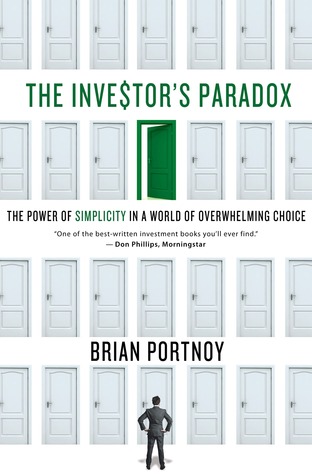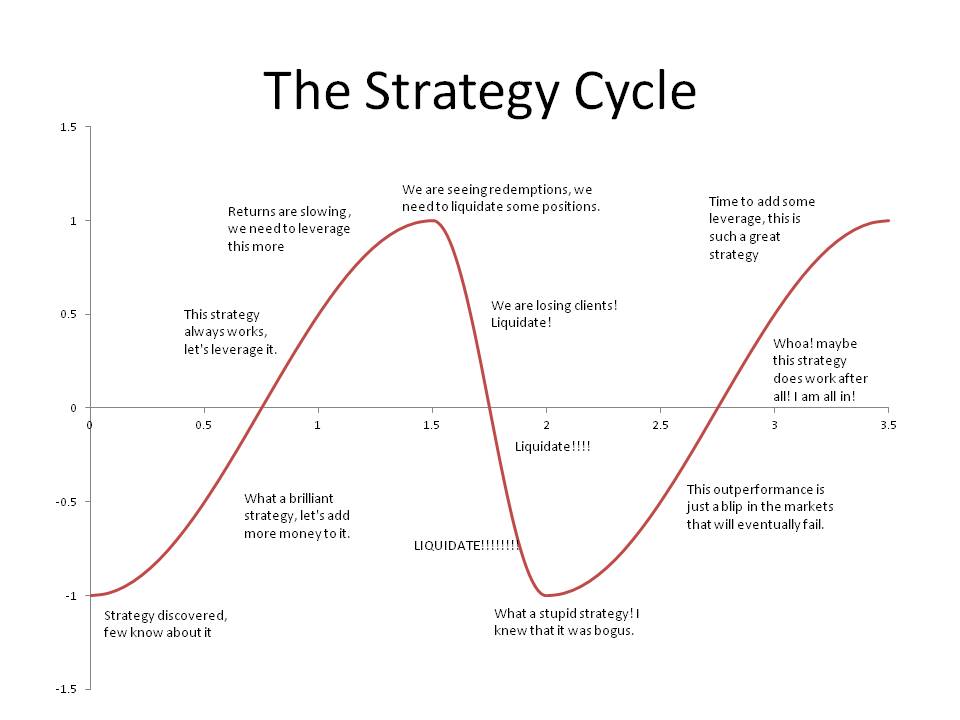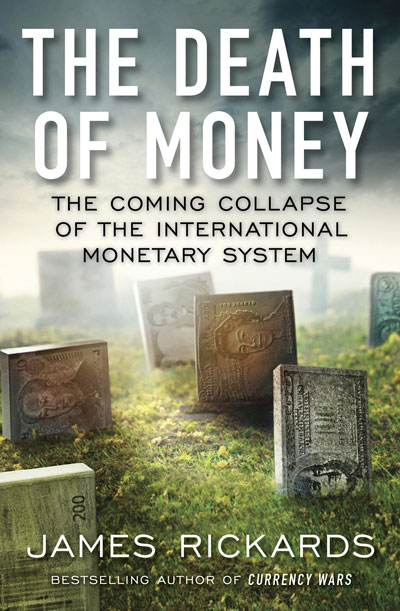Redacted version of the April 2014 FOMC Statement
| March 2014 | April 2014 | Comments |
| Information received since the Federal Open Market Committee met in January indicates that growth in economic activity slowed during the winter months, in part reflecting adverse weather conditions. | Information received since the Federal Open Market Committee met in March indicates that growth in economic activity has picked up recently, after having slowed sharply during the winter in part because of adverse weather conditions. | Weather is always a weak reason for a bad result.? You almost never see anyone claim good weather boosted results.
Didn?t they see today?s weak GDP report? |
| Labor market indicators were mixed but on balance showed further improvement. The unemployment rate, however, remains elevated. | Labor market indicators were mixed but on balance showed further improvement. The unemployment rate, however, remains elevated. | No significant change.? What improvement?? Note: this is the one remaining place where they mention the ?unemployment rate.? Shh. |
| Household spending and business fixed investment continued to advance, while the recovery in the housing sector remained slow. | Household spending appears to be rising more quickly. Business fixed investment edged down, while the recovery in the housing sector remained slow. | Shades household spending down, lowers their view on business fixed investment. |
| Fiscal policy is restraining economic growth, although the extent of restraint is diminishing. | Fiscal policy is restraining economic growth, although the extent of restraint is diminishing. | No change.? Funny that they don?t call their tapering a ?restraint.? |
| Inflation has been running below the Committee’s longer-run objective, but longer-term inflation expectations have remained stable. | Inflation has been running below the Committee’s longer-run objective, but longer-term inflation expectations have remained stable. | No change.? TIPS are showing slightly lower inflation expectations since the last meeting. 5y forward 5y inflation implied from TIPS is near 2.41%, up 0.15% from March. |
| Consistent with its statutory mandate, the Committee seeks to foster maximum employment and price stability. | Consistent with its statutory mandate, the Committee seeks to foster maximum employment and price stability. | No change. Any time they mention the ?statutory mandate,? it is to excuse bad policy. |
| The Committee expects that, with appropriate policy accommodation, economic activity will expand at a moderate pace and labor market conditions will continue to improve gradually, moving toward those the Committee judges consistent with its dual mandate. | The Committee expects that, with appropriate policy accommodation, economic activity will expand at a moderate pace and labor market conditions will continue to improve gradually, moving toward those the Committee judges consistent with its dual mandate. | No change. |
| The Committee sees the risks to the outlook for the economy and the labor market as nearly balanced. | The Committee sees the risks to the outlook for the economy and the labor market as nearly balanced. | No change. |
| The Committee recognizes that inflation persistently below its 2 percent objective could pose risks to economic performance, and it is monitoring inflation developments carefully for evidence that inflation will move back toward its objective over the medium term. | The Committee recognizes that inflation persistently below its 2 percent objective could pose risks to economic performance, and it is monitoring inflation developments carefully for evidence that inflation will move back toward its objective over the medium term. | No change.? CPI is at 1.5% now, yoy. |
| The Committee currently judges that there is sufficient underlying strength in the broader economy to support ongoing improvement in labor market conditions. | The Committee currently judges that there is sufficient underlying strength in the broader economy to support ongoing improvement in labor market conditions. | No change. |
| In light of the cumulative progress toward maximum employment and the improvement in the outlook for labor market conditions since the inception of the current asset purchase program, the Committee decided to make a further measured reduction in the pace of its asset purchases. Beginning in April, the Committee will add to its holdings of agency mortgage-backed securities at a pace of $25 billion per month rather than $30 billion per month, and will add to its holdings of longer-term Treasury securities at a pace of $30 billion per month rather than $35 billion per month. | In light of the cumulative progress toward maximum employment and the improvement in the outlook for labor market conditions since the inception of the current asset purchase program, the Committee decided to make a further measured reduction in the pace of its asset purchases. Beginning in May, the Committee will add to its holdings of agency mortgage-backed securities at a pace of $20 billion per month rather than $25 billion per month, and will add to its holdings of longer-term Treasury securities at a pace of $25 billion per month rather than $30 billion per month. | Reduces the purchase rate by $5 billion each on Treasuries and MBS.? No big deal.
|
| The Committee is maintaining its existing policy of reinvesting principal payments from its holdings of agency debt and agency mortgage-backed securities in agency mortgage-backed securities and of rolling over maturing Treasury securities at auction. | The Committee is maintaining its existing policy of reinvesting principal payments from its holdings of agency debt and agency mortgage-backed securities in agency mortgage-backed securities and of rolling over maturing Treasury securities at auction. | No change |
| The Committee’s sizable and still-increasing holdings of longer-term securities should maintain downward pressure on longer-term interest rates, support mortgage markets, and help to make broader financial conditions more accommodative, which in turn should promote a stronger economic recovery and help to ensure that inflation, over time, is at the rate most consistent with the Committee’s dual mandate. | The Committee’s sizable and still-increasing holdings of longer-term securities should maintain downward pressure on longer-term interest rates, support mortgage markets, and help to make broader financial conditions more accommodative, which in turn should promote a stronger economic recovery and help to ensure that inflation, over time, is at the rate most consistent with the Committee’s dual mandate. | No change.? But it has almost no impact on interest rates on the long end, which are rallying into a weakening global economy. |
| The Committee will closely monitor incoming information on economic and financial developments in coming months and will continue its purchases of Treasury and agency mortgage-backed securities, and employ its other policy tools as appropriate, until the outlook for the labor market has improved substantially in a context of price stability. | The Committee will closely monitor incoming information on economic and financial developments in coming months and will continue its purchases of Treasury and agency mortgage-backed securities, and employ its other policy tools as appropriate, until the outlook for the labor market has improved substantially in a context of price stability. | No change. Useless paragraph. |
| If incoming information broadly supports the Committee’s expectation of ongoing improvement in labor market conditions and inflation moving back toward its longer-run objective, the Committee will likely reduce the pace of asset purchases in further measured steps at future meetings. | If incoming information broadly supports the Committee’s expectation of ongoing improvement in labor market conditions and inflation moving back toward its longer-run objective, the Committee will likely reduce the pace of asset purchases in further measured steps at future meetings. | No change.? Says that purchases will likely continue to decline if the economy continues to improve. |
| However, asset purchases are not on a preset course, and the Committee’s decisions about their pace will remain contingent on the Committee’s outlook for the labor market and inflation as well as its assessment of the likely efficacy and costs of such purchases. | However, asset purchases are not on a preset course, and the Committee’s decisions about their pace will remain contingent on the Committee’s outlook for the labor market and inflation as well as its assessment of the likely efficacy and costs of such purchases. | No change. |
| To support continued progress toward maximum employment and price stability, the Committee today reaffirmed its view that a highly accommodative stance of monetary policy remains appropriate. | To support continued progress toward maximum employment and price stability, the Committee today reaffirmed its view that a highly accommodative stance of monetary policy remains appropriate. | No change. |
| In determining how long to maintain the current 0 to 1/4 percent target range for the federal funds rate, the Committee will assess progress–both realized and expected–toward its objectives of maximum employment and 2 percent inflation. This assessment will take into account a wide range of information, including measures of labor market conditions, indicators of inflation pressures and inflation expectations, and readings on financial developments. | In determining how long to maintain the current 0 to 1/4 percent target range for the federal funds rate, the Committee will assess progress–both realized and expected–toward its objectives of maximum employment and 2 percent inflation. This assessment will take into account a wide range of information, including measures of labor market conditions, indicators of inflation pressures and inflation expectations, and readings on financial developments. | Monetary policy is like jazz; we make it up as we go.? Also note that progress can be expected progress ? presumably that means looking at the change in forward expectations for inflation, etc. |
| The Committee continues to anticipate, based on its assessment of these factors, that it likely will be appropriate to maintain the current target range for the federal funds rate for a considerable time after the asset purchase program ends, especially if projected inflation continues to run below the Committee’s 2 percent longer-run goal, and provided that longer-term inflation expectations remain well anchored. | The Committee continues to anticipate, based on its assessment of these factors, that it likely will be appropriate to maintain the current target range for the federal funds rate for a considerable time after the asset purchase program ends, especially if projected inflation continues to run below the Committee’s 2 percent longer-run goal, and provided that longer-term inflation expectations remain well anchored. | No change.? Its standards for raising Fed funds are arbitrary. |
| When the Committee decides to begin to remove policy accommodation, it will take a balanced approach consistent with its longer-run goals of maximum employment and inflation of 2 percent. | When the Committee decides to begin to remove policy accommodation, it will take a balanced approach consistent with its longer-run goals of maximum employment and inflation of 2 percent. | No change. |
| The Committee currently anticipates that, even after employment and inflation are near mandate-consistent levels, economic conditions may, for some time, warrant keeping the target federal funds rate below levels the Committee views as normal in the longer run. | The Committee currently anticipates that, even after employment and inflation are near mandate-consistent levels, economic conditions may, for some time, warrant keeping the target federal funds rate below levels the Committee views as normal in the longer run. | No change. |
| With the unemployment rate nearing 6-1/2 percent, the Committee has updated its forward guidance. The change in the Committee’s guidance does not indicate any change in the Committee’s policy intentions as set forth in its recent statements. | That sentence lasted only one month.? Note that the phrase ?unemployment rate? is close to being banned by the FOMC.? The dual mandate is not so dual, at least in the old sense. | |
| Voting for the FOMC monetary policy action were: Janet L. Yellen, Chair; William C. Dudley, Vice Chairman; Richard W. Fisher; Sandra Pianalto; Charles I. Plosser; Jerome H. Powell; Jeremy C. Stein; and Daniel K. Tarullo.
|
Voting for the FOMC monetary policy action were: Janet L. Yellen, Chair; William C. Dudley, Vice Chairman; Richard W. Fisher; Narayana Kocherlakota; Sandra Pianalto; Charles I. Plosser; Jerome H. Powell; Jeremy C. Stein; and Daniel K. Tarullo. | Kocherlakota rejoins the majority, even with no change to the ?fifth paragraph? of the March statement. |
| Voting against the action was Narayana Kocherlakota, who supported the sixth paragraph, but believed the fifth paragraph weakens the credibility of the Committee’s commitment to return inflation to the 2 percent target from below and fosters policy uncertainty that hinders economic activity. | Thus ends the lamest vote against an FOMC decision that I have ever seen.? The differences between the last statement?s fifth and sixth paragraphs were minuscule. |
Comments
- Small $10 B/month taper.? Equities and long bonds both rise.? Commodity prices fall.? The FOMC says that any future change to policy is contingent on almost everything.
- They shaded household spending down, and lowered their view on business fixed investment.? Don?t know they keep an optimistic view of GDP growth, especially amid falling monetary velocity.
- At least they are abandoning the unemployment rate as their measure of labor conditions.
- They missed a real opportunity to simplify the statement.? More words obfuscate, they do not clarify.
- In the past I have said, ?When [holding down longer-term rates on the highest-quality debt] doesn?t work, what will they do?? I have to imagine that they are wondering whether QE works at all, given the recent rise and fall in long rates.? The Fed is playing with forces bigger than themselves, and it isn?t dawning on them yet.
- The key variables on Fed Policy are capacity utilization, unemployment, inflation trends, and inflation expectations.? As a result, the FOMC ain?t moving rates up, absent increases in employment, or a US Dollar crisis.? Labor employment is the key metric.
- GDP growth is not improving much if at all, and much of the unemployment rate improvement comes more from discouraged workers, and part-time workers.




